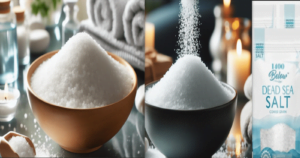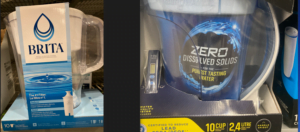Brita and PUR are two popular brands that manufacture water filtration products designed to improve the taste and quality of tap water. Brita uses activated carbon filters to attract and hold impurities like chlorine, sediment, and heavy metals in water. While PUR combines activated carbon filters and ion exchange tech to both adsorb impurities, such as lead and copper, and reduce heavy metals in water.
Brita and PUR water filters both utilize activated carbon filters to adsorb impurities like chlorine and sediment. However, PUR stands out with additional ion exchange technology, offering enhanced heavy metal reduction, particularly for lead and copper.
Brita’s standard filters operate akin to a sieve, employing carbon to decrease mercury levels and mitigate the taste and odor of chlorine. Additionally, these filters incorporate an ion-exchange resin to effectively filter out zinc, copper, and cadmium. The filtration process involves pores that serve as a selective barrier, regulating the passage of various components. These pores vary in size, influencing the outcomes of the filtration process.
Differences between Brita and PUR water filtration systems:

| Brita Water filter | PUR Water Filter |
|---|---|
| Filtration Technology: Primarily uses activated carbon filters. These filters work by adsorbing (attracting and holding) impurities and contaminants in the water, including chlorine, sediment, and some heavy metals. | Filtration Technology: Uses a combination of activated carbon filters and ion exchange technology. In addition to adsorbing impurities like Brita, PUR’s ion exchange process can also reduce heavy metals like lead and copper. |
| Effectiveness: Effective at improving the taste and odor of tap water by removing common impurities. | Effectiveness: Effective at improving the taste and odor of tap water by removing common impurities. However, PUR may have a slight edge when it comes to reducing certain contaminants like heavy metals. |
| Certifications: Brita filters are certified by the NSF (National Sanitation Foundation) for specific contaminant reduction claims. The exact certifications may vary depending on the specific model and filter type. | Certifications: PUR products are also NSF certified, and they often have a broader range of certifications due to their ion exchange technology, which allows them to reduce a wider variety of contaminants. |
| Product Range: Both brands offer a variety of water filtration products, including pitchers, faucet attachments, dispensers, and refrigerator filters. They also offer different types of filters, including standard and specialized filters for specific needs. | Product Range: Both brands offer a variety of water filtration products, including pitchers, faucet attachments, dispensers, and refrigerator filters. They also offer different types of filters, including standard and specialized filters for specific needs. |
| Filter Lifespan and Cost: Brita dose not last as long as PUR filters. However, the cost of replacement filters can also vary based on the specific model and type. | Filter Lifespan and Cost: PUR filters tend to last slightly longer than Brita filters. The cost of replacement filters can also vary based on the specific model and type. |
| Design and Features Both brands offer a range of designs and features to cater to different consumer preferences. This includes factors like pitcher size, shape, and the type of indicator used to signal when it’s time to replace the filter. | Design and Features Both brands offer a range of designs and features to cater to different consumer preferences. This includes factors like pitcher size, shape, and the type of indicator used to signal when it’s time to replace the filter. |
| Availability: Widely available in many countries through various retailers, both online and in physical stores. | Availability: Widely available in many countries through various retailers, both online and in physical stores. |
PUR water filter and how long it last
The effectiveness of a PUR water pitcher depends on what you’re looking to achieve and the specific model you’re using. Generally, PUR water pitchers are designed to reduce certain contaminants commonly found in tap water, such as chlorine, lead, mercury, and some microbial cysts. They use activated carbon and ion exchange to achieve this.
A PUR faucet filter can effectively treat approximately 100 gallons of water over a span of 2 to 3 months. Pitcher and dispenser filters offer up to 40 gallons of clean water for around 2 months, while PUR refrigerator filters can purify about 100 to 200 gallons of water for up to 6 months.
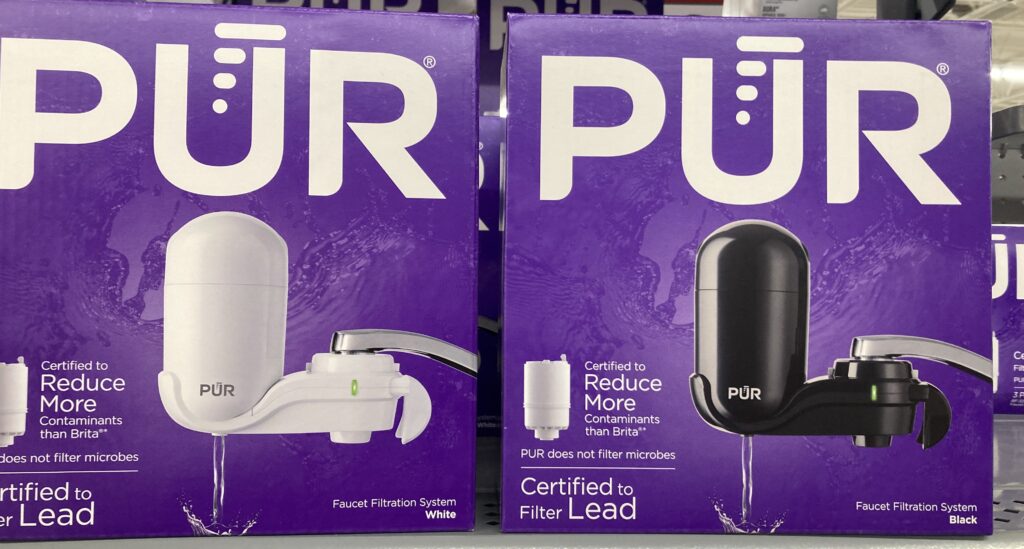
Most PUR filters are equipped with indicator lights in various colors, including green, yellow, and red, which serve as a guide for when to replace them.
When the yellow light on the PUR water filter blinks, it indicates that the filter should be replaced soon. The red light blinking signifies that the filter is no longer functional and requires immediate replacement. Conversely, the green light indicates that the filter is effectively treating the water.
Points to consider regarding the effectiveness of a PUR water pitcher:
- Chlorine Reduction: PUR pitchers are effective at reducing chlorine taste and odor. Chlorine is commonly added to municipal water supplies for disinfection, but it can affect the taste and smell of the water.
- Lead Reduction: PUR pitchers are certified to reduce lead. This is an important feature if your water supply has lead pipes or fixtures, which can leach lead into the water.
- Microbial Cyst Reduction: PUR pitchers are also designed to reduce microbial cysts like Cryptosporidium and Giardia, which can cause gastrointestinal illnesses.
- Mercury, Zinc, and Other Contaminants: Depending on the specific model and the type of filters used, PUR pitchers may also be effective at reducing other heavy metals like mercury and minerals like zinc.
- Filter Lifespan: The effectiveness of a PUR pitcher can diminish as the filter reaches the end of its lifespan. It’s crucial to replace the filter according to the manufacturer’s recommendations.
- Flow Rate: Some users have reported that the flow rate of water through a PUR pitcher can be slower as the filter becomes clogged with contaminants. Regular filter replacement can help maintain optimal flow.
- pH and Mineral Content: Unlike some advanced filtration systems, PUR pitchers do not typically alter the pH or mineral content of the water. The water should maintain its natural characteristics.
- Contaminants Not Removed: It’s important to note that not all contaminants are removed by a PUR pitcher. For example, it may not be as effective at removing dissolved minerals (like calcium or magnesium), certain volatile organic compounds (VOCs), or some bacteria and viruses.
- Water Source Quality: The effectiveness of any water filtration system, including PUR, depends on the initial quality of the water. If your tap water has an unusually high concentration of specific contaminants, you might need a more advanced filtration system.

Remember to replace your Genuine PUR Faucet filters every 3 months or 100 gallons for maximum chemical and physical contaminant reduction. Products.
Remember to always follow the manufacturer’s instructions for installation and maintenance. Regular filter replacement is crucial for maintaining the effectiveness of any water filtration system.
If you have specific concerns about your water quality, you might consider having your water tested to identify the contaminants present and choose a filtration system that specifically addresses those issues.
Limitations Of PUR water filter
Pur water filters are designed to remove various impurities from tap water, providing a relatively simple and cost-effective way to improve water quality. However, like any water filtration system, they have some limitations:
- Limited Contaminant Removal: While PUR filters are effective at reducing many common contaminants like chlorine, lead, and certain microbial cysts, they may not eliminate all types of pollutants. For instance, they may not be as effective at removing certain heavy metals, industrial chemicals, or dissolved minerals.
- Filter Lifespan: The filters have a finite lifespan, and they need to be replaced regularly. The exact lifespan depends on factors like the quality of the source water and the amount of water being filtered. This can be an ongoing cost.
- Flow Rate Reduction: As the filter gets clogged with impurities, it can reduce the flow rate of the water. This means it might take longer to fill a container or to get water from the faucet.
- Temperature Sensitivity: PUR water filters may not perform as effectively with extremely hot water. The high temperature can potentially damage the filter and reduce its efficacy.
- Not Suitable for Well Water: If your water source is a private well, PUR filters may not be sufficient to handle the unique contaminants that can be found in well water, such as bacteria, sediment, or specific minerals.
- Not a Replacement for Boiling: While PUR filters are good at reducing common contaminants, they may not be enough to purify water that is known to be contaminated with harmful pathogens. In such cases, boiling or using a more advanced water purification system may be necessary.
- Not Ideal for High TDS (Total Dissolved Solids): PUR filters may not be as effective at reducing certain minerals and salts that contribute to high TDS levels. In areas where high TDS is a concern, a dedicated reverse osmosis system may be more suitable.
- Not Portable: Some PUR water filters are designed for attachment to a faucet or for use in a pitcher. They are not easily portable for use in situations like camping or travel.
- Initial Cost and Maintenance: While the ongoing cost of filter replacement is a consideration, there is also an initial investment in purchasing the filter unit itself.
- Not Certified for All Contaminants: Depending on the specific model, PUR filters may be certified to remove specific contaminants. It’s important to verify what contaminants a particular model is designed to address.
Remember, the effectiveness of any water filter, including Pur, can vary depending on the specific contaminants in your water source. If you have specific concerns about your water quality, it may be beneficial to have your water tested to identify which contaminants are present and to determine the best filtration solution for your needs.
Brita water filter
BRITA water filters work through a process called activated carbon filtration. Here’s how it works:
- Activated Carbon: The core component of a BRITA filter is activated carbon. Activated carbon is a form of carbon that has been processed to have a large surface area, which makes it effective for adsorbing (not absorbing) impurities and contaminants from water.
- Adsorption: When water passes through the activated carbon filter, the contaminants in the water adhere to the surface of the carbon particles. This process is called adsorption. The activated carbon is highly porous, providing a large surface area for contaminants to stick to.
- Contaminant Removal: Activated carbon is particularly effective at removing organic compounds, such as chlorine, volatile organic compounds (VOCs), and other impurities that affect the taste and odor of water. It can also remove some heavy metals and certain chemicals.
- Ion Exchange Resin (in some models): Some BRITA filters also use an ion exchange resin in addition to activated carbon. This resin helps to reduce the concentration of metals like lead and copper, which can be present in tap water due to aging pipes.
- Mechanical Filtration (in some models): In addition to the chemical filtration provided by activated carbon and ion exchange resin, some BRITA filters may also have a mechanical filtration stage. This typically involves a fine mesh or sieve that physically traps larger particles.
- Filtered Water: After passing through the various filtration stages, the water emerges on the other side as purified and improved in taste and odor.
- Indicator System (in some models): Many BRITA pitchers and dispensers come with a filter change indicator. This is usually a simple gauge or electronic system that reminds you when it’s time to change the filter. Over time, the activated carbon becomes saturated with contaminants and becomes less effective.
Remember that while BRITA filters can significantly improve the taste and quality of tap water, they may not be able to remove all types of contaminants. For instance, they may not be as effective at removing minerals, salts, or certain types of bacteria and viruses.
Always refer to the specific instructions and recommendations provided by BRITA for the model of filter you are using, as there may be slight variations in how different models operate.
How long dose Brita water filter last
The approximate replacement rates for various Brita filters:
Pitcher and Dispenser Filters:
- Brita Standard Filter: Every 2 months
- Brita Longlast+ Filter: Every 6 months
- Brita Stream Filter: Every 2 months
Bottle and Faucet Filters:
- Brita Premium Filtering Water Bottles: Every 2 months
- Brita Water Filter Faucet System Model OPFF-100: Every 4 months
- Brita Water Filter Faucet System Model SAFF-100: Every 4 months
- Brita Water Filter Faucet System Model FF-100: Every 4 months
Types of Brita Products
1. Brita pitchers use replaceable filters that contain activated carbon, which is effective in reducing chlorine, bad odors, and tastes from tap water. Some models also feature ion exchange resin that can help reduce heavy metals like lead. The pitcher itself is typically made of plastic and has a lid and a spout for easy pouring. The filter is usually placed in the reservoir section of the pitcher, and water is poured into the top.

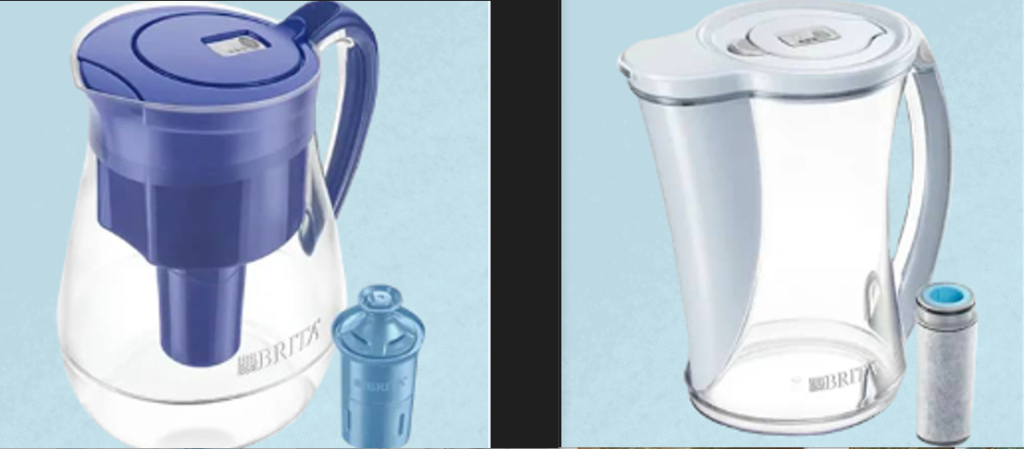
Brita offers various pitcher models with different features, sizes, and designs to suit different preferences and needs. Some may have electronic filter change indicators to remind users when it’s time to replace the filter.
2. Brita dispensers: The Brita dispenser boasts a generous 27-cup capacity, accommodating over a gallon of water. Its slim design facilitates convenient storage, making it an ideal choice for space-conscious users.
Brita emphasizes the longevity of its filter, which is designed to last for a period of 6 months. The dispenser comes equipped with an electronic filter replacement indicator, allowing users to easily monitor and determine when it’s time to replace the filter.

In terms of filtration performance, Brita asserts that its filter surpasses competitors by reducing a higher percentage of contaminants, including an impressive 99% reduction of lead. This underscores the dispenser’s commitment to providing clean and purified water for users.
3.Water bottles: The Brita water bottle boasts a double-wall construction, purportedly ensuring that water stays cold for a full 24 hours. With a capacity of 20 ounces (Oz), this bottle incorporates a filter placed within the straw, designed to purify water as it is consumed. According to Brita, the filter is crafted from a distinctive combination of activated carbon and a binding agent. The company asserts that the filter is free from BPA, effectively minimizing chlorine taste and odor, as well as reducing particulates.

4. Faucet systems: Brita offers faucet systems designed for filtering tap water. The recommended interval for changing the filter, as stated by Brita, is approximately every four months on average. The filter is capable of purifying 100 gallons of water before requiring replacement. Users can easily monitor the need for replacement by utilizing the filter replacement indicator provided by Brita. Brita also carry three types of water faucet as listed Below
- Basic water Faucet : Brita Basic Water Filter Faucet System effortlessly connects to your faucet and comes with a 100-gallon filter. This system is designed to eliminate 99% of lead and diminish the levels of chlorine (both taste and odor), benzene, asbestos, and trichloroethylene from your tap water. It comes with
- 1 included filter = 100 gallons of filtered water
- Easy setup; installs in minutes
- Filter replacement indicator
- Find a Retailer
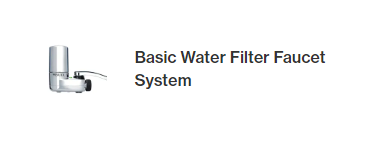
2. Complete water filter faucet: The Water Filter Faucet System is equipped with a convenient built-in reminder light, ensuring that you stay informed about the optimal time to replace the filter. Additionally, it offers three distinct spray options to enhance your water usage experience. Comes with
- 1 included filter = 100 gallons of filtered water
- Easy setup; installs in minutes
- 3 spray options
- Electronic filter indicator

3. Complete water Filter Faucet System with 2 filters:
The system includes two high-performance filters, offering an impressive filtration capacity of up to 200 gallons. With an easy and swift setup, you can have the faucet system installed within minutes, providing instant access to purified water.
In addition to its efficient filtration capabilities, the faucet system also boasts three distinct spray options, allowing you to customize your water usage based on your specific needs. Whether you prefer a gentle stream or a more robust flow, the system accommodates your preferences.
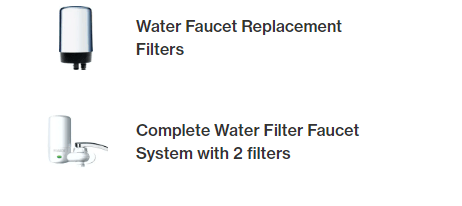
Experience the convenience of the electronic filter indicator, making maintenance hassle-free. With this intuitive feature, you’ll always be aware of the filter’s status, ensuring that your water remains consistently pure. Upgrade your kitchen with the Complete Water Filter Faucet System for a seamless blend of functionality and convenience.
Limitations of Brita water filter
While BRITA water filters are effective at improving the taste and quality of tap water, they do have some limitations:
- Limited Contaminant Removal: While BRITA filters are good at removing certain impurities like chlorine, volatile organic compounds (VOCs), and some heavy metals, they may not be as effective at removing minerals, salts, bacteria, viruses, or certain chemicals. They are not designed to purify water from highly contaminated or unsafe sources.
- Filter Lifespan: The effectiveness of a BRITA filter diminishes over time as it becomes saturated with contaminants. It’s important to change the filter regularly according to the manufacturer’s recommendations. Failure to do so can lead to reduced filtration efficiency.
- Flow Rate: Filtering water through a BRITA system can take some time, especially if the filter is clogged or nearing the end of its lifespan. This can be a minor inconvenience for users who need a constant supply of filtered water.
- Initial Investment and Ongoing Costs: The initial purchase of a BRITA system, whether it’s a pitcher, faucet attachment, or a dispenser, can involve a cost. Additionally, there are ongoing expenses for replacement filters. While it’s generally more cost-effective than purchasing bottled water, it’s an expense to consider.
- Not Suitable for All Water Sources: BRITA filters are designed for use with municipal tap water that meets certain quality standards. They may not be suitable for use with well water or water from unregulated or highly contaminated sources.
- Limited Capacity: The capacity of a BRITA filter is limited to the volume of the container it’s installed in. This means that if you have a high demand for filtered water, you may need to refill the pitcher or container frequently.
- Not a Solution for Hard Water: BRITA filters are not designed to remove hardness minerals like calcium and magnesium. If your water is very hard, you may need a separate water softening system.
- Environmental Considerations: While using a BRITA filter reduces the need for single-use plastic water bottles, the filters themselves need to be disposed of. Some parts of the filter may be recyclable, but others may need to be thrown away.
It’s important to note that while BRITA filters have these limitations, they are still a practical and effective solution for many households seeking to improve the taste and quality of their tap water. If you have specific concerns about the quality of your water, you may want to consider having it professionally tested or exploring other filtration options.








